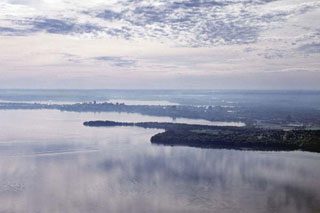Water, water everywhere focus of new sustainability project
An interdisciplinary team of scientists and engineers at the University of Wisconsin–Madison is turning a comprehensive lens on Madison’s water in all its forms — in the lakes, streets, faucets, ground and atmosphere — thanks to the National Science Foundation.

A new five-year, nearly $5 million grant from the National Science Foundation will support a comprehensive study of the Madion’s Yahara watershed.
Photo: Jeff Miller
Five UW–Madison professors, including two of the campus’s most-lauded ecologists, recently received a five-year, nearly $5 million grant from the NSF to study the complex links between the water system and factors such as land use, climate change, human activities, development and ecosystems. Their work will focus on the Yahara watershed, which includes all of Madison’s lakes.
The grant is part of a new NSF Water Sustainability and Climate program that is exploring ways to maintain a sufficient supply and quality of freshwater in the face of changing climate and growing demand, while balancing often-competing needs such as development, agriculture, human use and conservation.
“There’s not a better example of the issues regarding urbanization,” says UW–Madison agronomy and environmental studies professor Chris Kucharik, who spearheaded the new project. “Madison is a moderate-sized city that’s growing quickly. There is increasing water use due to the growing population, we’re experiencing climate change, which is likely to increase extreme weather events, and it’s an agricultural watershed.”
One focus of the new project is to better understand and predict the effects of policy decisions and other human activities, especially within the context of a changing climate. “When you start putting together all of these different drivers, what might that mean to the future of the watershed in terms of quality of life, sustainability of the environment, the lakes and our groundwater supplies?” he asks.
Local residents have probably already noticed events such as flooding, runoff into the lakes, unusually high or low lake levels, and algae blooms, Kucharik says, and it’s important to understand how future changes may impact the system.
The complexity of the issues — which touch on everything from energy production and food prices to city planning and recreation — requires much more than a “just the facts” type of scientific approach. “We don’t want to spend five years collecting data in the field and running models across the watershed to find out that it wasn’t the right information,” Kucharik says.
Instead the scientists are tackling an integrated approach that combines scientific modeling, field data collection, stakeholder input, public engagement, outreach and education to take a broad view of the many factors at play.
One element is the development of a set of “integrated scenarios” with the help of landowners, policymakers, community members, and other stakeholders to gauge people’s perceptions and identify real-world issues and the types of information that will be useful to address them.
“The integrated scenarios will use narratives to help couple scientific models with what the future of the watershed might look like,” explains co-principal investigator Adena Rissman, to help people see likely outcomes under various conditions — such as climate changes, suburban growth or land-use decisions.
The scientists’ goal is not to decide what the future should look like, she emphasizes, but rather to synthesize the best available information to help policymakers and others understand how to work toward a target outcome.
“Whenever you’re talking about a public policy question or a political process, it’s really the community values that should drive that process and the role of science in that process,” says Rissman, who is an assistant professor of forest and wildlife ecology. “There are a lot of different perspectives in the watershed and a lot of different goals that need to be met simultaneously, so the better we can understand the tradeoffs and clarify decisions, the better we’ll be able to meet a divergent set of goals and interests.”
They are also partnering with Edgewood College, Wisconsin Public Television and the Lakeshore Nature Preserve to reach students and the public. The planned projects include a new informational “water walk” along the Lake Mendota shore, a series of television programs, and hands-on research opportunities for undergraduates interested in sustainability.
The project is already bringing together a broad base of researchers who span many campus boundaries and whose expertise runs the gamut from the natural and social sciences to engineering. Of the five co-investigators, Kucharik and Rissman are part of the College of Agricultural and Life Sciences; Monica Turner, professor of zoology, and Stephen Carpenter, director of the UW–Madison Center for Limnology, hail from the College of Letters & Science; and Steven Loheide is a professor of civil and environmental engineering in the College of Engineering. Most of the investigators are also affiliated with the Nelson Institute for Environmental Studies.
“This is a new way of doing things, and UW is really well positioned because of the expertise we have on campus. There are no barriers between colleges,” Kucharik says. “We hope to develop the tools needed to manage water resources in the built and natural environments in a way that balances social, economic and environmental considerations and enables future generations to do the same.”
Ultimately, he hopes, their findings will be applicable to other urban water systems such as the western Milwaukee-eastern Waukesha County corridor, which is studded with lakes and is undergoing rapid development. But for now, the focus is on the Yahara watershed.
“As a scientist, I want to help solve the problems here. That’s why we want to do this,” says Kucharik, who himself lives near Token Creek. “But when it’s your home territory, it takes on even more meaning.”
Tags: College of Letters & Science, ecology, research, water




